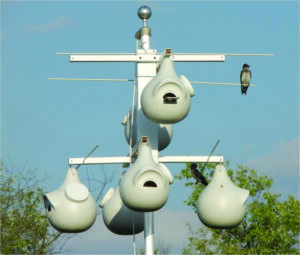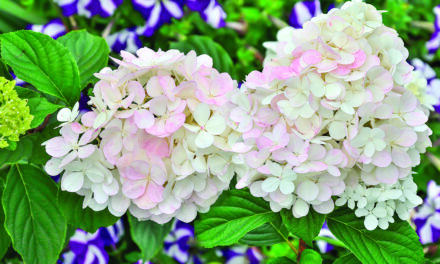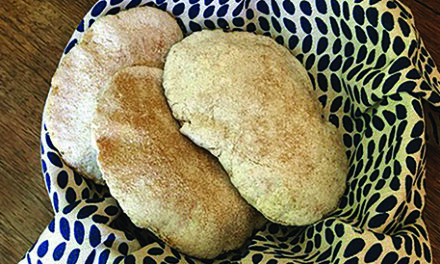
Purple Martin housing construction evolved to reflect human architecture with decorative mini two-story apartment complex designs in a variety of styles. But enthusiast Bill Whelan and others have found that the Native American gourd shape, with its deeper interior, provides greater overall protection from numerous predators. (Photo courtesy Bill Whelan)
Even as a kid, birds had fascinated Bill Whelan.
There were no airports within sight of his Laurel schoolhouse window.
But thanks to a nearby homeowner who had erected an avian apartment unit atop a towering pole, he discovered the sheer joy of watching Purple Martins display daring aerobic skill.
He became hooked for life on learning about and living near the soaring songbirds, who, though smaller than robins, are largest among the U.S. swallow family.
His dad put up a Purple Martin house, he recalls. And throughout the places he has settled as an adult, Whelan, now in his 70s, has also become a “human landlord,” creating Martin multifamily nesting units on his property.
President of the Purple Martin Society of Frederick, Whelan, now living in nearby Keymar, also presides over a colony consisting of 25 to 30 plastic gourd shaped clustered cavities affixed to telescoping poles, providing seasonal nesting shelter during the birds’ spring and summer layover before returning to Brazil.
He readily admits to much trial and error over the years. It’s taken time to learn that though “second year” hatchlings return, they lack the know how and experience to successfully ward off intruders.
It’s the “third year” birds that are better candidates to establish a successful colony. Also, despite superb flight skills, Martins are most vulnerable to aerial predators during takeoff and landing, so allow at least a 180 by 250 foot “runway” sector allowing safe passage to and from the cavity. Whelan also added that recent research has debunked Martins’ age-old reputation for consuming copious numbers of mosquitos; they feed primarily on larger insects such as dragonflies and bees.
In short, attracting and fostering a Purple Martin colony is more than simply build it, and they will come. It is crucial first to learn about the breed’s needs and history. According to the Purple Martin Conservation Association, they are known as secondary cavity nesters, using space already created by other animals or in naturally occurring locales like cliffs and rock formations.
Think old woodpecker holes, rock ledges, or dead trees.
As these naturally occurring spaces declined, indigenous peoples began providing man-made housing for the Purple Martins with dried, hollowed-out gourds.
Over time, the birds preferred human built dwellings, effectively shifting breed behavior completely within the Eastern species.
Purple Martin housing construction evolved to reflect human architecture with decorative mini two-story apartment complex designs in a variety of styles.
But Whelan and others have found that the Native American gourd shape, with its deeper interior, provides greater overall protection from numerous predators.
These include other birds, including Cooper’s and sharp shinned hawks and owls, as well as land-based hunters including raccoons, squirrels, cats, and snakes (who can slither up the tall poles).
Prospective landlords should consider a variety of predator proofing methods prior to erecting housing.
The PMCA website suggests the following safeguards:
• First, choose an area away from any tall trees. Citing personal experience over the years, Whelan recommends at least 100 feet distance. Also, add hawk/owl Guards and wire cages, available commercially, to the cavity opening entryway. Hawks hunt by day, owls by night. Post decoys to distract hawks, who pursue the slowest bird, buying time for the real birds to escape.
• Install pole guards (baffles) to deter snakes and raccoons. Whether 12 or 20 feet high, round or square, metal or wood, poles pose a risk for climbing. Commercial or homemade, in cone or cylinder shapes, guards should measure 8 inches across and 2 feet long, install at least 4 feet above the ground.
• Bird (or butterfly) netting offers extra protection to trap larger snakes; place above predator baffle in puffy layers, leaving no space for the snake to climb between the netting and pole, or over the netting.
• Besides predators, purple martin housing is often at risk from feisty real estate competitors such as House and Tree Swallows, House Wrens, Eastern Bluebirds, and Great Crested Fly Catchers, who generally beat the bulk of the Purple Martin population in arriving back to their nesting sites.
• To secure the sites from unintended feathered squatters, Whelan has had success following PMCA guidelines, which suggest setting up “alternate” housing units to attract the intruders away. He attaches several gourd shaped apartments off to either side of the main colony unit pole, and this has been working. He also recommends temporarily taping up the other entrances until after the non-Martin settlers establish their homesteads.
Chesapeake Wildlife Heritage, which has been building and managing Purple Martin housing for 30 years, discovered that erecting the poled units on docks over water and adding crescent shaped entryways both effectively deterred primarily land-loving House Sparrows.
Andi Pupke, CWH Outreach/Education Coordinator, added that the group also considers challenging weather conditions in managing the Martins under their care. Reporting in the group’s newsletter she wrote:
“Not only do Purple Martins migrate long distances in the spring and fall facing treacherous weather throughout their migration. They can also experience harsh weather once they reach their destination. Cold, wet springs can cause the demise of Martins who have depleted their body fat stores traveling great distances to reach their breeding grounds. Martins feed on flying insects, so if it is too cold or wet for insects to fly, the martins have nothing to eat. CWH staff have spent many wet hours flinging crickets and mealworms into the air near the martin colony trying to feed them. We have also cooked scrambled eggs and placed them on raised feeders for the martins.”
Monitoring insecticide use in your area is helpful in protecting the colony, Pupke added. And severe weather events, such as a fierce strait wind derecho in 2012, with hurricane force winds, resulted in reinforced structures.
Whelan, who carefully tracks his winged tenants, attests to the helpful practice of flinging food bits skyward for the Martins’ emergency mid-air meals. He also carefully lowers the telescoping poles throughout the season to monitor each cavity’s occupancy and well-being.
Along with devoting himself to the Martins under his care, Whelan wonders who the breed’s future caretakers will be, and hopes to interest upcoming generations. A few years ago, a visitor from Austin, Texas, attending FEMA training in the area, found his group online. Whelan said he was delighted to learn that the man worked with a Boy Scout troop and was teaching them about Purple Martins. He hopes that others affiliated with youth organizations will do the same.
For more information, visit https://purplemartinsociety.org/, https://www.purplemartin.org/, and http://www.cheswildlife.org/.






